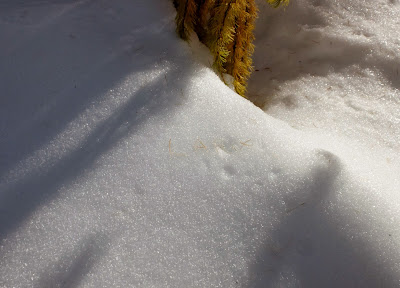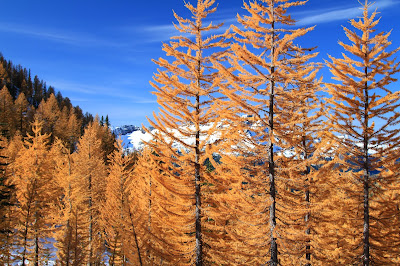Left: Larix Spelled in Needles in the Snow; Right: Larch Branch on Carne Mountain
“It’s a matter of elevation” the young man informed us. When trying to decide what kind of larch you are looking at, think about your elevation. According to him, since we were near the top of Carne Mountain, and we were above 6,000 feet, we were looking at subalpine (or just alpine) larch, Larix lyallii. The other type of larch in the Northwest is the western larch, Larix occidentalis.
In this Binomen Art series post, we are spelling out Larix, the scientific name for the larch genus. We spell out the name with the golden needles of larch on snow. Larch are conifers and deciduous. They shed their needles, but before they do, there is site to behold.
The young man –we had about 20 years on him – was carrying a book. Really, he was clutching it, and it being Northwest Trees: Identifying and Understanding the Region’s Native Trees by Stephen Arno and illustrated by Ramona P. Hammerly. The first edition of this book appeared in 1977. When our copy arrived a few days later, we immediately took a liking to it. This beautifully illustrated guide book really captures the “character” of the trees in an engaging way that books full of detailed photographs often miss.
The chapters on western larch and alpine larch sounded strangely familiar as the book-clutcher has recited quite literally from the book as we’ll do:
In the Cascades, alpine larch can be found from central Washington’s Wenatchee Mountains northward about 120 miles (190 km) just into the southern edge of British Columbia. It is found mainly above 6000 feet (1800 m) … [Northwest Trees, p 49]
On the Carne Mountain hike, we hit the larches as we entered the Carne Basin (a cirque I believe) at about 6,100 feet. So by elevation, it was most likely L. lyalli. According to Northwest Trees [p 43], the western larch (L. occidentalis) grows up to about 6,000 feet. Beyond elevation you can also use other simple diagnostics to distinguish between the two species. According to Pacific Coast Tree Finder [pocket manual] and other sources, if the needles are four-sided, it’s an alpine larch. If the needles are three-sided, it’s a western larch. If only we thought to twirl the needles between our fingers. Another way to help distinguish between the two species of larches is to look at the current-year twigs: for alpine larch they are woolly and for western larch they are not.
According to Quattrocchi, the generic name origin is:
From the Latin classical name larix, icis “a larch, larch tree,” used by Plinius and Vitruvius; see P. Sella, Glossario latino italiano. Stato della Chiesa – Veneto – Abruzzi. Città del Vaticano 1944.
As an aside: there really is a Glossario latino italiano. And, if you search inside the book for “larice” (larch in Italian), you see there is an something written. Unfortunately, we can’t see much of it. We’ll trust Quattrocchi on this.
The specific epithet occidentalis means “western”, while lyalli honors the Scot David Lyall (1817–1895).
Left: Trail Through Carne Basin to Carne Mountain and Area of Larch (Google Earth); Right: Larix spelled with Larch Needles in the Snow

Left: Larch Trees in Carne Basin; Center: Trail from Carne Basin to the Carne Mountain Peak; Right: Larch Cones on Carne Mountain





No comments:
Post a Comment
All comments are moderated. If your comment doesn't appear right away, it was likely accepted. Check back in a day if you asked a question.